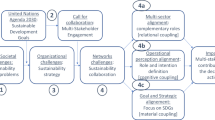Abstract
‘Multiple use systems’ are systems that allow efficient and effective supply of water from different sources to communities for their domestic and for their productive purposes and that allow interaction with providers of water related services. Such systems are probably highly desirable from the perspective of using scare water efficiently and also from the perspectives of gender equity and improving livelihoods. It is therefore useful to carry out scientific research to validate this statement about a water-innovation. The mode of research must be ‘action research’. The specific form and management of multiple use systems depends on local biophysical and socio-economic factors, as well as on local institutions and legislation. Eleven ‘cornerstones’ need to be in place to realize a full multiple use system. Since a blue print cannot be made and many parties are involved, ‘learning alliances’ are to be set up in specific geographic areas and at national level to identify how much of these cornerstones of multiple use systems are still lacking, and to work together to create or implement these. Guidelines for setting up Learning Alliances and for actually implementing systems of multiple water use are needed.
Similar content being viewed by others
References
Biswas AK (2004) Integrated water resources management: a re-assessment. Water International 29(2):248–256
Boelee ES, Morardet J, Butterworth J (2004) Report of the MUS basin workplan workshop, Nov. 2004. IWMI, Pretoria, S. Africa, pp 90
CPWF (2005) CGIAR Challenge Program Water for Food. www.waterforfood.org
Engel P (1995) Facilitating innovation: an action-oriented approach and participatory methodology to improve innovative social practice in agriculture. PhD-thesis. Wageningen University, Wageningen, the Netherlands
Faysse N (2004) An assessment of small scale user's inclusion in large scale water users associations of South Africa. Research Report 84, IWMI, Pretoria, pp 36
Gonsalves JF, Mendoza LC (2003) External review of IDRC's community-based natural resource management program initiative in Asia. Final Report, IDRC, Ottawa, Canada, pp 60
Hagmann J (2005) LearningWheel — Creating common frameworks for joint learning and knowledge management: a methodology for conceptualising experiences in multi-stakeholder fora. (forthcoming, for information: jhagmann@aol.com)
Lundi M (2002) Learning Alliances with development partners. CIAT, 2002. Consulted on internet.
Merrey DJ, Drechsel P, Penning de Vries FWT, Sally H (2005) Integrating `livelihoods' into integrated water resources management: taking the integration paradigm to its logical next step for developing countries. Regional Environmental Change (on line journal, DOI10/1007/s10013-004-0088-5)
Moriarty PB, Butterworth JA, van Koppen B (eds) (2004) Beyond domestic. case studies on poverty and productive uses of water at the household level. IRC Technical Papers Series 41. Delft: IRC, NRI, and IWMI pp 350
Moriarty PB, Fonseca C, Smits S, Schouten T (2005) Learning Alliances for scaling up innovative approaches in the water and sanitation sector. In: Smits S, Fonseca C, Pels J (eds) Proceedings Symposium on Learning Alliances for scaling up innovative approaches in the water and sanitation sector. Delft, the Netherlands, June 2005, www.irc.nl/page/16676
MUS (2005) A literature base on publications about multiple use systems. http://www.iwmi.cgiar.org/ multipleuses/files/multiuseqry.htm
Penning de Vries, FWT, Niamskul C, Bechstedt HD, Maglinao A, Sajjapongse A (2000) Participatory approaches for sustainable use of sloping land in Asia, pp 203–215. In: Roetter R et al. (eds) Systems research for optimizing future land use. IRRI, Los Banos, Philippines pp 266
Ruaysoongnern S, Penning de Vries FWT (2005) Learning Alliances development for scaling up of multi-purpose farm ponds in a semi-arid region of the Mekong basin. In: Smits S, Fonseca C, Pels J (eds) Proceedings of the symposium on Learning Alliances for scaling up innovative approaches in the water and sanitation sector. Delft, the Netherlands, June 2005, www.irc.nl/page/16676
Van der Hoek W, Konradsen F, Ensink JHJ, Mudasser M, Jensen PK (2001) Irrigation water as a source of drinking water: is safe use possible? Tropical Medicine and International Health 6:46–55
Van Koppen B (2001) Gender in integrated water management: an analysis of variation. Natural Resources Forum 25 (2001) 299–312. Elsevier Science Ltd, United Nations
Van Koppen B et al. (2005) Multiple use systems: an assessment. IWMI, Pretoria, S Africa. (in prep)
Visscher JT, Garcia M, Roling N (2005) Multi-stakeholder learning in Colombia. In: Smits S, Fonseca C, Pels J (eds) Proceedings Symposium on Learning Alliances for scaling up innovative approaches in the water and sanitation sector. Delft, the Netherlands, June 2005. www.irc.nl/page/16676
World Bank Group (2002) Millennium Development Goals. http://www.developmentgoals.org/
Yoder R (1983) Non-agricultural uses of irrigation systems: past experience and implications for planning and design. ODI Network paper 7, Overseas Development Institute, London
Author information
Authors and Affiliations
Corresponding author
Additional information
Manuscript for the International Conference on ’Integrated Assessment of Water Resources and Global Change: A North-South Analysis’, 23–25 February 2005, Bonn, Germany (http://www.zef.de/watershed2005). Submitted after review and revision 21 October 2005.
The paper is based on extensive discussions and notes on multiple use systems shared among the members of the MUS project and others in November 2004, including E. Boelee, J. Butterworth, T. Cousins, A. Duran, J. Hagmann, B. Mintesinot, S. Morardet, P. Moriarty, I.Restrepo, S.Ruaysoongnern,S. Suryarwanshi, S. Smits, B. van Koppen and B. Yoder.
Rights and permissions
About this article
Cite this article
Vries, F.W.T.P.d. Learning Alliances for the broad implementation of an integrated approach to multiple sources, multiple uses and multiple users of water. Water Resour Manage 21, 79–95 (2007). https://doi.org/10.1007/s11269-006-9042-2
Published:
Issue Date:
DOI: https://doi.org/10.1007/s11269-006-9042-2




